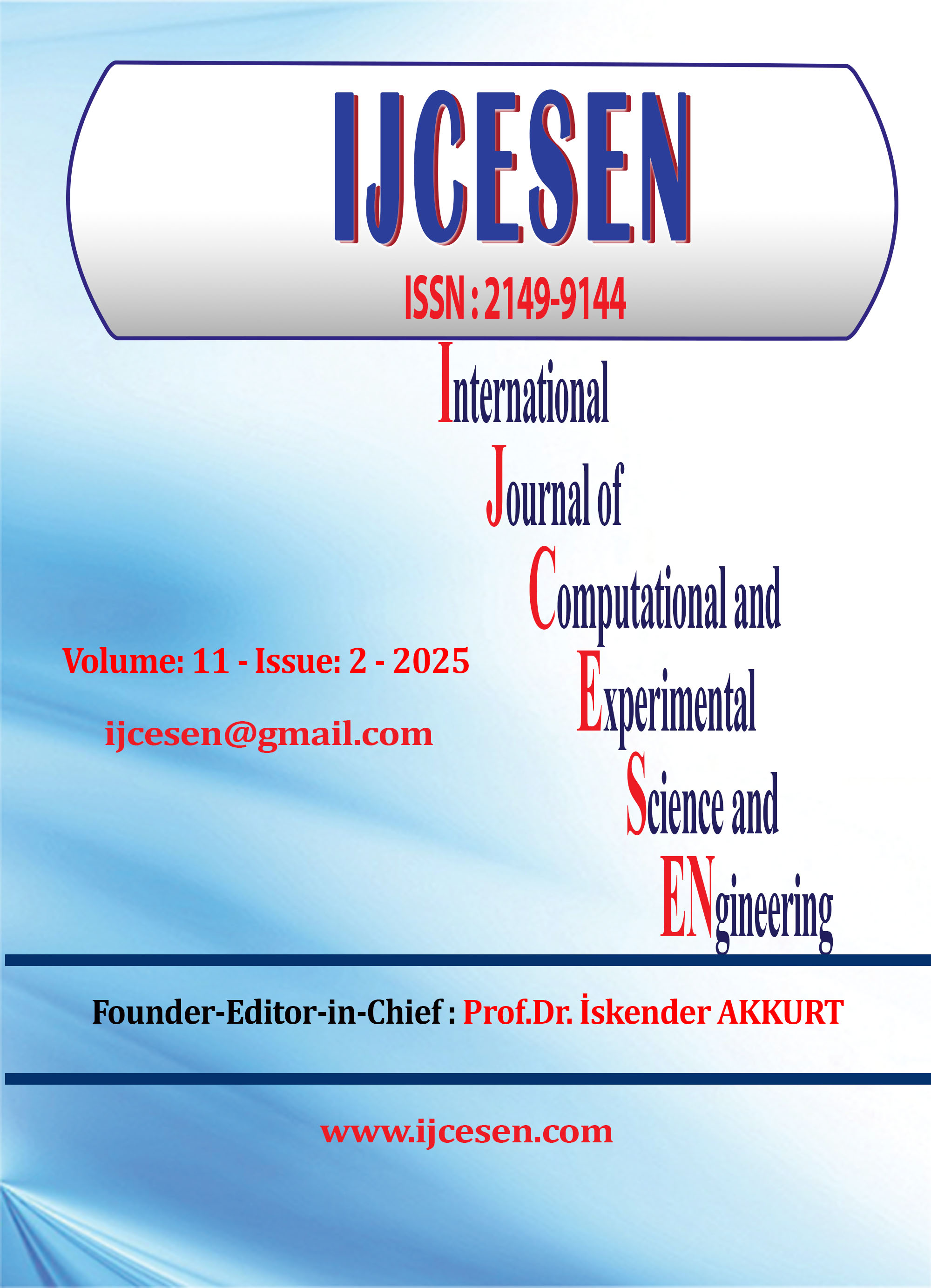Simulation and Design for Waste Heat Recovery in Electric Arc Furnace Metal Pools
DOI:
https://doi.org/10.22399/ijcesen.766Keywords:
Electric Arc Furnace, Metal Pools, Waste Heat, Recovery, Carbon EmissionAbstract
A significant amount of waste heat is generated in the metal pools during the production of high carbon ferrochrome in electric arc furnaces. This waste heat manifests itself in the form of heat emitted to the atmosphere from the metal pools and the temperature of the flue gases. Although there are many studies on waste heat recovery from flue gases, there is limited research on waste heat recovery in metal pools. In this study, the recovery of waste heat generated in metal pools in ferrochrome production at Eti Krom INC., the world's largest producer of hard piece chromium, was investigated. The product produced during ferrochrome production is left to cool in metal pools. The initial temperature of ferrochrome metal, which starts to cool in the pools, is between 700-800 °C. In this context, the proposed system consists of heating the water circulating in the pipe from 15-20 °C to 85-90 °C by utilising the waste heat with the heat exchanger system mounted under the metal pools. Different numerical simulations have shown that the designed system can successfully heat water to 85-95 °C by utilising waste heat. Economic analyses were made for the designed system to be obtained by energy recovery from waste heat. As a result, it was determined that the energy required to raise 10 m3 of water from 15 °C to 85 °C with this system is 813 kWh energy and this energy is equivalent to 195 kg coal or 91 m3 natural gas consumption. In addition, the recovery of waste heat in the metal pools through this system significantly reduces waste heat and carbon emissions in the atmosphere by reducing fossil fuel consumption.
References
[1] Kacynski, T. J. (1996). Industrial Society and Its Future. İstanbul: Kaos Publications.
[2] Ersoy Mirici, M., & Berberoğlu, S. (2022). The Green Deal and Carbon Footprint from Turkey’s Perspective: Is It a Threat? Is It an Opportunity?. Journal of Natural Hazards and Environment. 8(1): 156-164, DOI: 10.21324/dacd.982396
[3] Uçak S., & Villi B., (2021), Possible Effects of The European Green Deal on The Steel Industry, Journal of Empirical Economics and Social Sciences, 3(2), 94-113., DOI: 10.46959/jeess.987971
[4] Liu, J., Yu, Q., Zuo, Z., Duan, W., Han, Z., Qin, Q., & Yang, F. (2016). Experimental Investigation on Molten Slag Granulation For Waste Heat Recovery From Various Metallurgical Slags, Applied Thermal Engineering, 103,1112–1118, DOI: 10.1016/j.applthermaleng.2016.05.011.
[5] Zuo, Z., Feng, Y., Dong, X., & Luo, Siyi. (2022). Advances in Recovery of Valuable Metals and Waste Heat from Copper Slag, Fuel Processing Technology, 235(777);107361, DOI: 10.1016/j.fuproc.2022.107361.
[6] Congedo, P, M., Colangelo, G., & Starace, G. (2012). CFD Simulations of Horizontal Ground Heat Exchangers: A Comparison Among Different Configurations, Applied Thermal Engineering, vol. 33–34(1); 24–32, DOI: 10.1016/j.applthermaleng.2011.09.005.
[7] Cao, S., Kong, X, Deng, Y., Zhang, W., Yang, L., & Ye, Z. (2017). Investigation on Thermal Performance of Steel Heat Exchanger for Ground Source Heat Pump Systems Using Full-Scale Experiments and Numerical Simulations. Applied Thermal Engineering, 115, 91-98, DOI: 10.1016/j.applthermaleng.2016.12.098.
[8] Jouhara, H., Almahmoud, S., Chauhan, A., Delpech, B., Nannou, T., Tassou, S. A., & Arribas, J. J. (2017). Experimental investigation on a flat heat pipe heat exchanger for waste heat recovery in steel industry. Energy Procedia, 123,329-334. DOI: 10.1016/j.egypro.2017.07.262
[9] Qin, S., & Chang, S., (2017). Modeling Thermodynamic and Techno-Economic Analysis of Coke Production Process with Waste Heat Recovery, Energy, 141; 435-450. DOI: 10.1016/j.energy.2017.09.105
[10] Tokgöz, N., & Özgün, Ö. (2019). A Review on Waste Heat Recovery Systems and a Case Study from Industry, Çukurova University Journal of the Faculty of Engineering and Architecture, 34 (2),57-72. DOI: 10.21605/cukurovaummfd.608955.
[11] Ikpe, A, E., Ndon, A, I, E., & Etim, P, J. (2020). A Conceptual Framework for Biothermal variations in Municipal Solid Waste landfill under Mesophilic Temperature Regime, International Journal of Computational and Experimental Science and Engineering 6 (3), 152-164. DOI: 10.22399/ijcesen.737662.
[12] Ergin, A., & Ergin, M, F. (2018). Reduction of Ship Based CO2 Emissions from Container Transportation, International Journal of Computational and Experimental Science and Engineering 4(3),1-4. DOI: 10.22399/ijcesen.429944
[13] Ollila, J., Niemela, P., Rouse, A., & Mattila, O. (2010, June 6-9). Preliminary Characterization of The Samples Taken from A Submerged Arc Ferrochrome Furnace During Operation, Ferrochromium Smelting, The Twelfth International Ferroalloys Congress Sustainable Future, Helsinki-Finland. https://www.pyrometallurgy.co.za/InfaconXII/000-CoverIntro.pdf
[14] Niemelä, P., Krogerus, H., & Oikarinen, P. (2004, February 1-4) Formation, Characteristics and Utilisation Of CO-gas Formed in Ferrochromium Smelting, Tenth International Ferroalloys Congress INFACON X: Transformation through Technology, Cape Town-South Africa. https://www.pyrometallurgy.co.za/InfaconX/014.pdf
[15] Yu, Y., Li, B., Qi, F., & Liu, Z. (2021). Modeling on Reduction Reaction of Metal Oxides for Submerged Arc Furnace in Ferrochrome Pellets Smelting Process, Metallurgical and Materials Transactions B52;3907-3919, DOI: 10.1007/s11663-021-02304-5
[16] Wang, Y., Zhu, J., Guo, Y., & Wang, C. (2023). Early Shrinkage Experiment of Concrete and The Development Law of Its Temperature and Humidity Field in Natural Environment, J. Build. Eng., 63; 105528, DOI: 10.1016/j.jobe.2022.105528.
[17] Jian, Y., Bai, F., Falcoz, Q., Xu, C., Wang, Y., & Wang, Z. (2015). Thermal Analysis and Design of Solid Energy Storage Systems Using A Modified Lumped Capacitance Method, Appl. Therm. Eng., 75;213–223, DOI: 10.1016/j.applthermaleng.2014.10.010.
[18] Albarthooth, A., Ramiar, A., & Ramyar, R. (2023). Earth-to-air Heat Exchanger for Cooling Applications in a Hot and Dry Climate: Numerical and Experimental Study, Int. J. Eng. Trans. C Asp., 36(1);78–89, DOI: 10.5829/ije.2023.36.01a.10.
Downloads
Published
How to Cite
Issue
Section
License
Copyright (c) 2025 International Journal of Computational and Experimental Science and Engineering

This work is licensed under a Creative Commons Attribution 4.0 International License.





